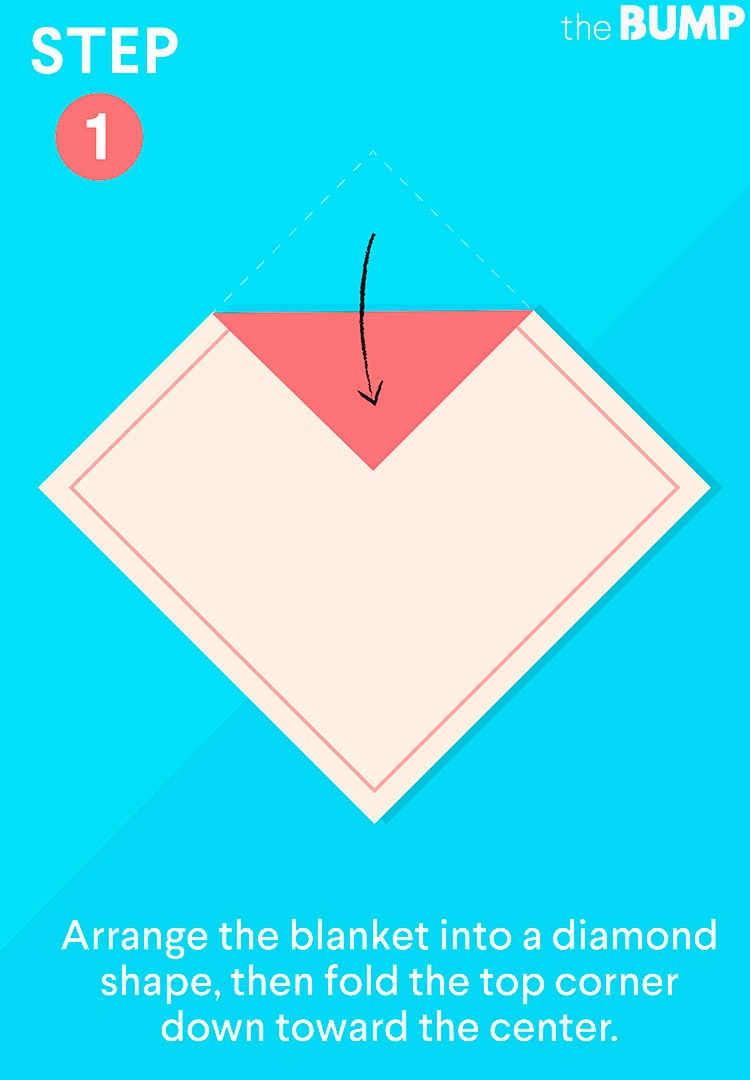Is your baby struggling to sleep? It might sound unconventional, but wrapping your baby snugly in a blanket – a technique known as swaddling – could be the solution you’ve been searching for. Swaddling is an age-old practice, going back thousands of years. Parents have used swaddles not just for sleep, but also to provide comfort, security, and calmness to their little ones. While it became less common in the 18th century, swaddling’s soothing benefits saw a resurgence around the 1970s. Today, with a growing appreciation for natural and time-tested baby care methods, swaddling is experiencing a revival, what pediatrician Dr. Harvey Karp calls a “renaissance.”
Keep reading to learn the proper way to swaddle a baby and discover why this technique can bring tranquility to your baby (and hopefully, more sleep for you too).
In this article, we’ll cover:
- What exactly is swaddling?
- Why is swaddling beneficial for babies?
- How safe is swaddling?
- Step-by-step instructions on How To Swaddle A Baby
- What to do if your baby resists swaddling
- When it’s time to stop swaddling your baby
What Is Swaddling?
Swaddling is the simple act of wrapping your baby snugly in a blanket, mimicking the secure and cozy feeling of being in the womb. You can start swaddling your baby from day one, for both naps and nighttime sleep. It provides a sense of being held, reduces the startle reflex (also known as the Moro reflex), and helps babies feel secure and comfortable. Experts, including Dr. Karp, author of The Happiest Baby on the Block, highly recommend swaddling as a method to soothe infants. Furthermore, the American Academy of Pediatrics (AAP) recognizes swaddling as a technique that can promote better sleep for babies.
Why Swaddle Your Baby?
“Swaddling recreates the familiar, comforting, and soothing sensation that a baby experienced in the womb,” explains Melissa Gersin, RN, a maternity nurse based in Boston and inventor of baby products. It provides a feeling of security because in the last months of pregnancy, babies have limited space in the womb and can only make small movements.
Swaddling can be beneficial anytime your baby is fussy or seems to be crying without an obvious reason (after checking for hunger or a dirty diaper). “Being swaddled is like getting a warm hug,” Gersin notes. This snug feeling can effectively calm a baby, especially when combined with other soothing techniques like gentle rocking and soft shushing sounds. When executed correctly, swaddling can also help babies fall asleep more quickly and stay asleep for longer stretches.
Is Swaddling Safe for Babies?
Some parents naturally worry about the safety of swaddling, particularly concerning Sudden Infant Death Syndrome (SIDS). It’s important to understand that swaddling itself does not directly cause SIDS. However, the American Academy of Pediatrics points out that while swaddling can lead to deeper sleep (the reason parents use it), decreased arousal has been linked to a slightly increased risk of SIDS. A 2016 study in Pediatrics journal emphasized that the recommendation to always place babies on their back to sleep is especially crucial when swaddling.
Therefore, if you choose to swaddle, always ensure your baby is placed on their back. Once your baby shows signs of being able to roll over in their sleep, it’s vital to discontinue swaddling altogether (more on this in the “When to Stop Swaddling Baby” section).
The AAP also advises against having loose blankets or soft objects in a crib for babies under 12 months due to suffocation risks. This is why safe swaddling practices are paramount. Here are essential safe sleep guidelines to keep in mind when learning how to swaddle a baby:
- Always place your baby on their back to sleep. Babies should always be placed on their back on a firm sleep surface. Stop swaddling as soon as your baby shows signs of rolling over. Remember the ABC’s of safe sleep: Alone, Back, Crib.
- Keep the crib free of soft items. Baby’s crib should be clear of loose bedding, stuffed animals, blankets, pillows, crib bumpers, and other soft items.
- Be mindful of overheating. Choose a lightweight, breathable swaddle blanket to avoid overheating. Heavy materials can make your baby too hot. Signs of overheating include sweating, flushed skin, or rapid breathing. If you notice these, remove a layer of clothing or the swaddle.
- Swaddle snugly, but not too tightly. The swaddle should be secure enough to prevent unraveling but not so tight that it restricts movement or breathing. Ensure the swaddle doesn’t straighten or bind baby’s legs, as this can lead to hip problems like hip dysplasia.
How to Swaddle a Baby, Step by Step
While pre-made swaddles with Velcro or zippers are available and easy to use, you can effectively swaddle your baby with a large, thin, and soft square blanket. (Explore our guide on [swaddle blankets](link to swaddle blankets shopping guide if available) for recommended options.)
Seeking guidance from a nurse or pediatrician on swaddling techniques is highly recommended, especially during your initial pediatrician visits or even before leaving the hospital. Newborn care classes are also excellent resources for hands-on swaddling instruction for both parents. At home, follow these step-by-step instructions, and for a visual aid, consider watching a video tutorial on [how to swaddle](link to video if available).
Image: Preparing the swaddle blanket by folding the top corner of a diamond-shaped blanket downwards to create a straight top edge.
Step 1: Lay a thin, square blanket on a flat surface in a diamond shape. Fold the top corner down towards the center, creating a straight top edge.
Image: Positioning a newborn baby face-up on the swaddle blanket, with their neck aligned with the straight top edge of the blanket.
Step 2: Position your baby face-up on the blanket, aligning their neck with the straight top edge. Pro-tip: Ensure the blanket doesn’t touch your baby’s cheek, as this might trigger their rooting reflex, causing them to become fussy thinking they are about to be fed.
Image: Securing the baby’s left arm down and wrapping the blanket tightly across their body, tucking it underneath their right side.
Step 3: Gently hold your baby’s left arm down along their side. (Keeping arms bent across their chest can allow them to wiggle free.) Take the blanket from about 4 inches from their left shoulder, pull it firmly across their body, and tuck it snugly underneath their right side. Ensure it’s snug but not too tight, without any loose fabric.
Image: Folding the bottom corner of the swaddle blanket up and over the baby’s legs and right arm, tucking it behind their right shoulder. Legs are shown slightly loose to allow movement.
Step 4: Take the bottom corner of the blanket and bring it up and over your baby’s legs and right arm, tucking this corner behind their right shoulder. Allow some looseness around the hips and legs to enable movement. While a secure wrap is needed, avoid swaddling too tightly around the legs, as overly restrictive swaddling can increase the risk of hip dysplasia.
Image: Completing the swaddle by wrapping the final corner across the baby’s body and tucking it in securely, showing a snug and secure final swaddle.
Step 5: Finally, take the remaining corner and pull it across your baby’s body (making sure their right arm is straight), and tuck it in securely. Double-check that the swaddle is snug and secure and won’t unravel as your baby moves. If the tuck loosens easily, you might need to restart or try a different blanket. Don’t worry if it takes practice; learning to swaddle takes time!
What If My Baby Doesn’t Like to Be Swaddled?
“Remember that many babies initially resist swaddling, or at least parents perceive it that way,” says Gersin. “This is often because babies are accustomed to having their arms up near their face in the womb. So, when you try to bring their arms down, they might resist. However, this resistance doesn’t necessarily mean they dislike being swaddled.”
Even if you have doubts, it’s worth trying the traditional swaddling technique. Hilary Thompson, a health and wellness consultant, recommends learning how to swaddle before your baby arrives so you can establish a routine from the start. Introducing swaddling later might be less effective.
If your baby resists, Gersin advises applying gentle, consistent pressure to straighten their arm. “After a few seconds, their muscles will relax, making it easier to position their arms straight down,” she says. If your baby still seems to prefer having their arms up, consider swaddling with arms free or using a swaddle sack that allows arms to be positioned upwards. These alternatives can still help minimize the startle reflex.
Some newborns and babies may be content without swaddling at all. However, for a [fussier baby](link to article about fussy baby if available), swaddling can become an invaluable calming tool. Don’t be discouraged if your baby doesn’t stop crying immediately upon being swaddled. As Dr. Karp explains, a swaddle might initially increase crying, but when followed by other calming techniques like swaying, shushing, and gentle motions, babies often calm down more effectively than without swaddling.
When to Stop Swaddling Baby
As babies grow older, their need for swaddling will naturally decrease. This is when you’ll start wondering how to transition out of swaddling.
Gersin suggests testing your baby’s readiness to transition by swaddling with one arm out. If they become fussy and struggle to sleep, they likely still benefit from swaddling. If they adapt well to the one-arm swaddle for about a week, they might be ready for the next step: Operation Swaddle Transition.
Gradually wean your baby by swaddling with both arms out. However, regardless of your baby’s preference, once they begin to roll over (or even attempt to), swaddling becomes unsafe and must be stopped completely. Sleeping on their stomach or with loose blankets increases the risk of suffocation and SIDS, as Thompson emphasizes. Your baby might need some time to adjust to sleeping without a swaddle, but this milestone signifies their growth and readiness to sleep freely, like a big kid!
Mastering how to swaddle a newborn is a skill that requires practice and patience. With a little persistence (and the right blanket!), you’ll become a swaddling pro in no time. Just remember to prioritize safe swaddling practices, and you’ll be well on your way to wrapping your baby for comfort and better sleep.
More helpful resources from The Bump:
[Baby Sleep Myths—Busted](link to baby sleep myths article if available)
[Tips for How to Get Baby to Sleep](link to baby sleep tips article if available)
[Wake Windows: How to Time Baby’s Sleep Just Right](link to wake windows article if available)


